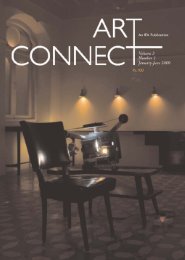Annual report 2003-2004 - India Foundation for the Arts
Annual report 2003-2004 - India Foundation for the Arts
Annual report 2003-2004 - India Foundation for the Arts
- No tags were found...
You also want an ePaper? Increase the reach of your titles
YUMPU automatically turns print PDFs into web optimized ePapers that Google loves.
mean that IFA has functioned without a clearsense of purpose and priorities, only that ourwork has not been motivated by considerationsextraneous to <strong>the</strong> arts. Indeed <strong>the</strong> perspectivesthat have framed our grant making, and <strong>the</strong>ways and means by which we have assisted <strong>the</strong>arts, are unprecedented in <strong>the</strong> <strong>India</strong>n context.IFA has emphasised that supporting journeysin <strong>the</strong> arts is as important as promoting<strong>the</strong>ir outcomes. We have encouraged artists todiscover new ways of producing art, to reachbeyond familiar <strong>for</strong>ms of expression in <strong>the</strong>irchosen disciplines, and to make new connections,sometimes with endeavours anddomains outside <strong>the</strong> arts. We have advocated<strong>the</strong> value of research and documentation notonly to ef<strong>for</strong>ts to conserve our cultural heritageand revitalise inherited <strong>for</strong>ms of artistic expression,but also in helping to lay <strong>the</strong> foundation<strong>for</strong> new creative endeavours and enablingtoday’s art to connect with its own history andleave a record <strong>for</strong> <strong>the</strong> future.New GrantsDuring <strong>2003</strong>-04, IFA invested nearly Rs 1.25crore in grants to seven organisations and 17individuals. Eleven grants are underwritingresearch and documentation on a wide rangeof subjects in different regions of <strong>the</strong> country.With our support, <strong>for</strong> example, manuscriptpaintings are being photographed in Assam,folk songs are being recorded and analysed inWest Bengal, heritage buildings are beingmapped in Sholapur, visual culture is beingdocumented in north Kerala, and literary practicesin nine languages are being tracked andtranslated in Mumbai. Five grants have gonetowards <strong>the</strong> production of films on studiophotography, popular music, women potters,street <strong>the</strong>atre and oral legends respectively. Inaddition, three grants were made tohelp disseminate <strong>the</strong> outcome ofresearch projects that IFA had fundedearlier.Under <strong>the</strong> arts collaboration programme,we made a supplementarygrant to enable three artists to continue workingtoge<strong>the</strong>r to develop innovative puppet <strong>the</strong>atreproductions and provide fur<strong>the</strong>r inputs to apuppetry group, led by children from <strong>the</strong> redlight area in Kolkata, which <strong>the</strong>y had helped toestablish earlier. And our ef<strong>for</strong>ts to enlarge <strong>the</strong>role of <strong>the</strong> arts in education gained momentumduring <strong>the</strong> year, as we were able to make fourdiverse grants to support interventions at bothsecondary and tertiary levels of education.Shifting PrioritiesThree of <strong>the</strong>se grants—which are respectivelyconcerned with introducing school children tomovement arts (in Bangalore), bamboo crafts(in Pune district), and built heritage (inKolkata)—reflect our new focus on supportingartists and arts groups to enliven <strong>the</strong>extracurricular space, since our experiencehas shown that educational institutions find itdifficult to propose imaginative arts educationinitiatives. IFA has also begun to pay more systematicattention to generating arts-relatedmaterials <strong>for</strong> reference and teaching. Partly asa result of two meetings convened in Mumbai,we expect in time to support two major projects—oneto create educational kits on <strong>India</strong>nart <strong>for</strong> use in schools, and <strong>the</strong> second to selectand annotate critical literature on <strong>the</strong> visual3This and facing page:T. Pankajaksha’s line drawings which <strong>for</strong>m part of hisdocumentation of traditions of sculpture in south <strong>India</strong>.See also pages 4-5 and 28-32.










